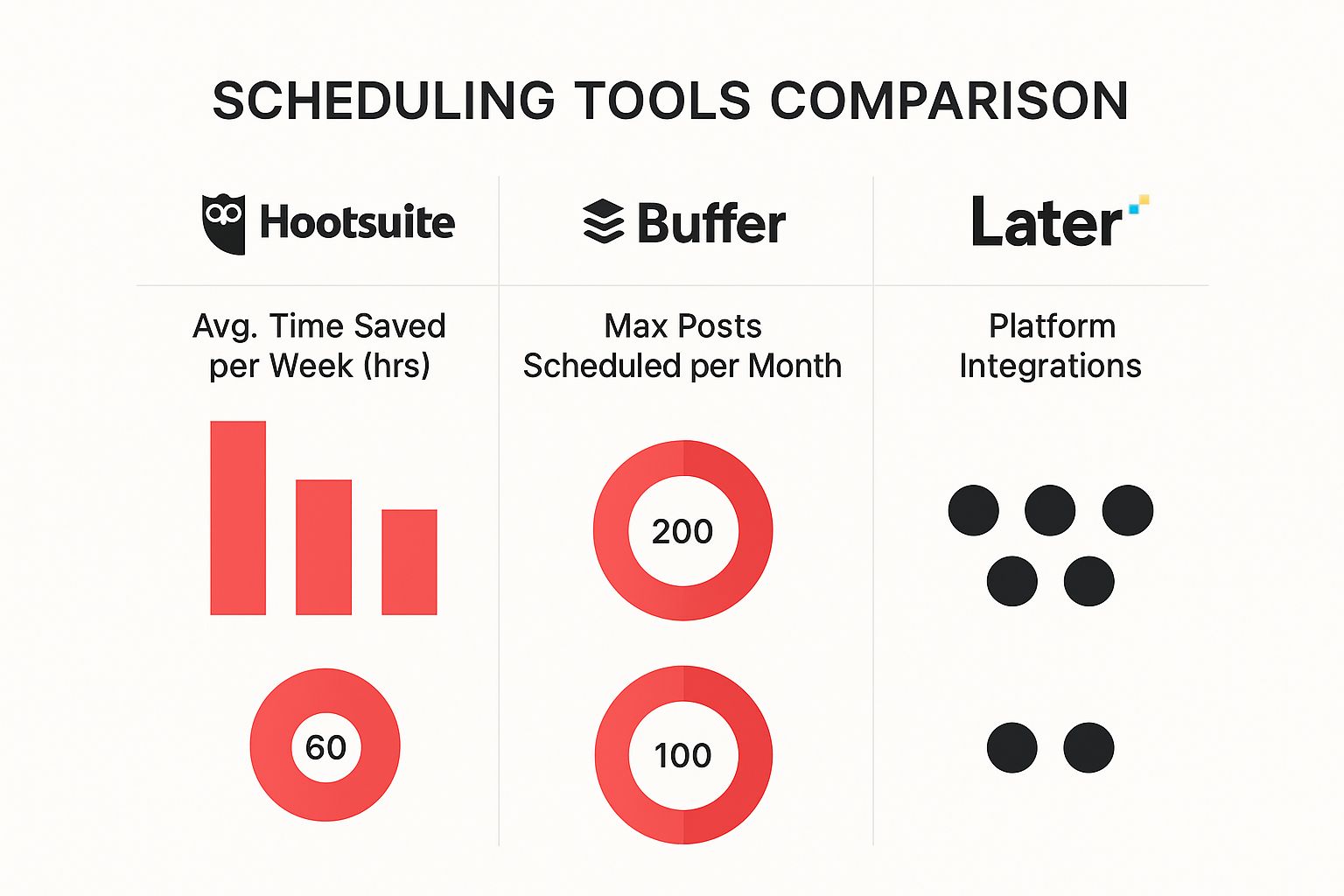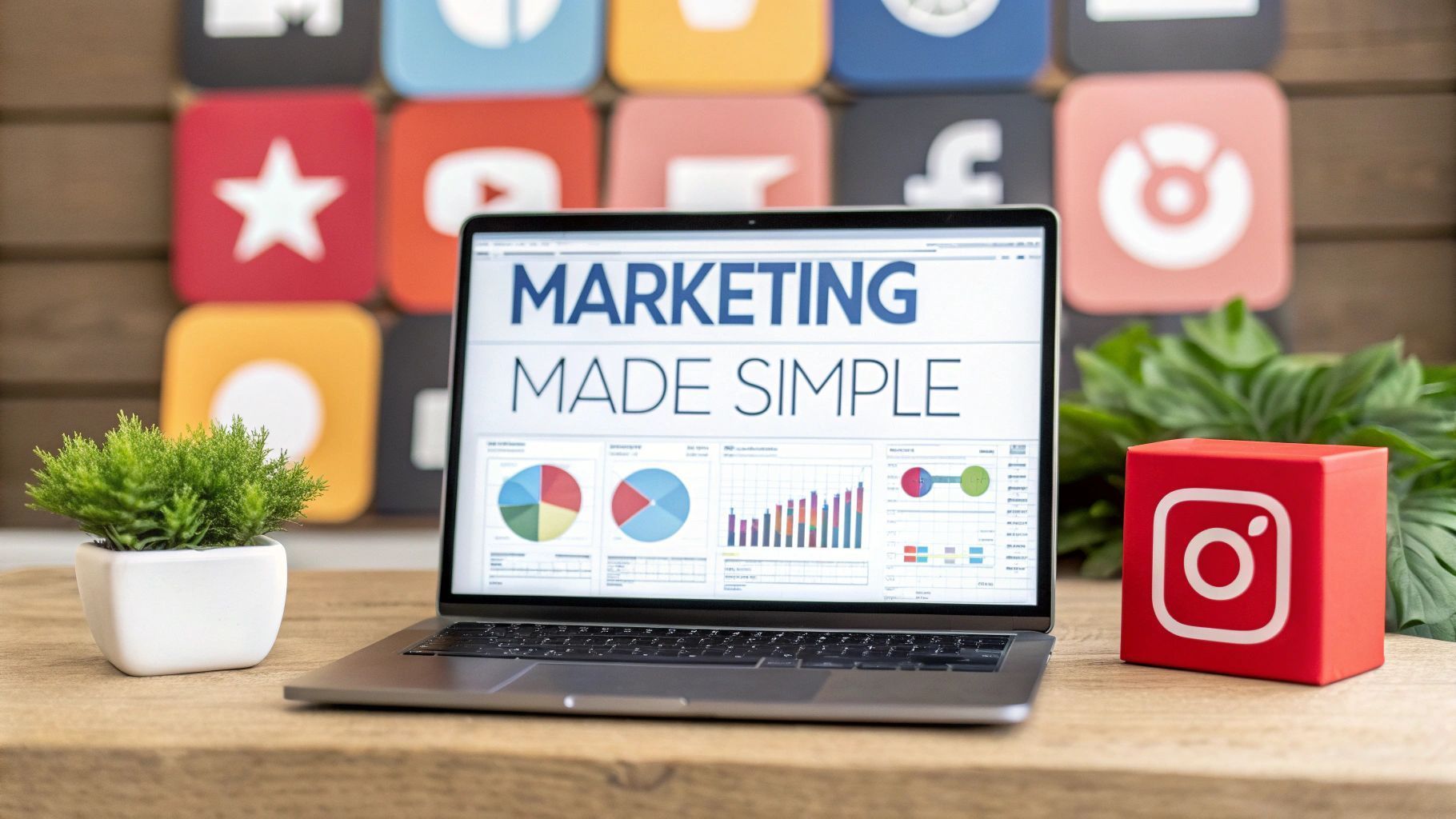Master Social Media Management for Business in the UK
Effective social media management for business isn't just about posting updates. It's the organised process of creating content, talking with your audience and tracking what works across different platforms to hit your company goals. It shifts your social channels from simple noticeboards into powerful engines for growth, customer loyalty and brand awareness.
Why Social Media Management Is a Growth Engine for Your Business
Too many UK businesses treat social media as a box-ticking exercise—a place to post occasionally and hope for the best. This completely misses the point. When you approach it with a real strategy, social media becomes a direct line to your customers, offering priceless insights and delivering measurable returns that genuinely impact your bottom line.
A well-executed plan is so much more than just scheduling posts. It means actively listening to what people are saying, getting a feel for market sentiment and engaging in a way that builds trust and creates a proper community.
Turning Platforms into Market Research Labs
The smartest British brands have figured out how to use their platforms as live feedback forums. Instead of dropping thousands on traditional market research, they just tune into the daily chatter to discover what customers really want.
For example, a UK-based cosmetics company started noticing a load of comments on their Instagram asking for a vegan-friendly version of their best-selling moisturiser. By tracking this feedback, their product team was able to fast-track a new formula and launch it to an audience that was already waiting to buy. This move didn't just boost sales; it showed everyone that the brand actually listens. This is a perfect example of why social media is important for your business , as it gives you direct access to what your customers are thinking.
By actively monitoring discussions and feedback, your social media channels become a rich source of data, guiding everything from product innovation to service improvements without the hefty price tag of formal research projects.
Driving Revenue and Boosting Customer Loyalty
Good social media management also has a direct effect on customer retention and sales. When customers get quick, helpful support on platforms like X (formerly Twitter), it can completely change how they see a brand.
Think about a popular online retailer whose delivery partner was causing delays. By proactively jumping on complaints on social media, offering apologies and giving clear updates, the customer care team managed to turn frustration into appreciation. One analysis of a similar situation found that this kind of timely, empathetic response boosted customer loyalty scores by as much as 30 percent .
The financial side of things is also huge. The UK social media management market is growing fast, projected to swell from around US$1.64 billion in 2024 to about US$5.25 billion by 2030. This growth is being fuelled by businesses finally realising its power for marketing, customer engagement and brand management.
Ultimately, social media management for business is about building relationships at scale. It’s a strategic role that pulls customer service, marketing and sales into one cohesive effort. By the end of this guide, you’ll understand how to build and run a plan that not only raises your brand's profile but also cements customer relationships for the long haul.
Building a Strategy Framework that Delivers Results

A clear plan is what separates businesses that succeed on social media from those that just make noise. Far too many companies get caught up in posting for the sake of it, but random content without a clear purpose is a fast track to wasted effort and poor returns.
Effective social media management starts with a solid strategy. This framework becomes your roadmap, making sure every tweet, story and update is intentionally designed to hit a specific business objective. It’s all about being intentional, not just busy.
Defining Your Social Media Objectives
Before you even think about what to post, you need to be crystal clear on what you want to achieve. Your social media goals can't exist in a silo; they should be directly tied to your wider business aims and most importantly, they have to be measurable.
Vague ambitions like "get more followers" won’t get you very far. Instead, you need to focus on specific, measurable, achievable, relevant and time-bound ( SMART ) objectives.
- Increase Brand Awareness: This is all about getting your name out there. A smart goal would be to increase your post reach by 20% over the next quarter.
- Generate Leads: Here, the aim is to find new potential customers. A concrete objective could be capturing 50 new email sign-ups per month through a LinkedIn lead generation form.
- Boost Community Engagement: This focuses on building real relationships. You might aim to increase the average number of comments per Instagram post by 30% within six months.
- Drive Website Traffic: Social media can be a powerful channel for sending visitors to your site. A good goal is to increase click-through rates (CTR) from Facebook by 15% in the next two months.
These clear targets give you direction and make it easy to see what’s working. For a deeper dive into how these goals fit into a bigger picture, you can explore our https://www.superhub.biz/what-is-digital-marketing-strategy-guide-to-boost-your-business to boost your business.
Mapping Your Audience Personas
You can't create content that resonates if you don't know who you're talking to. It sounds simple, but developing detailed audience personas is a crucial step that many businesses just skim over. This goes way beyond basic demographics like age and location.
You need to dig into their psychographics —their interests, values, pain points and online behaviour. Where do they hang out online? What kind of content do they actually stop and engage with?
A persona isn't just a fictional character. It's a research-based profile that represents your target customer. It helps you to create content that speaks directly to their needs and motivations, making your marketing far more effective.
For instance, a UK-based financial adviser might target two completely different personas: "Ambitious Anya," a 30-year-old tech professional in London who uses LinkedIn for career advice, and "Retired Robert," a 65-year-old in Devon who browses Facebook to connect with family. Their content needs and platform habits are worlds apart.
Conducting a Competitor Audit
Let's be clear: analysing your competitors isn’t about copying them. It’s about spotting gaps and opportunities in the market. A thorough competitor audit helps you understand what’s working for others in your niche and, more importantly, where you can carve out a unique space.
Take a look at these elements:
- Platform Presence: Which channels are they most active on? Where are they getting the most engagement?
- Content Themes: What topics do they cover? What’s their mix of promotional, educational and entertaining content?
- Engagement Rates: How are their followers responding? High likes but low comments might just indicate passive consumption.
- Brand Voice: What’s their tone? Is it formal, playful or professional?
By spotting a competitor who only posts dry corporate news on LinkedIn, you might see an opportunity to share behind-the-scenes stories and build a much more personal connection with your audience.
Crafting a Consistent Brand Voice
Finally, your brand voice is your personality online. A consistent voice builds familiarity and trust, making your brand instantly recognisable to UK audiences. It should be reflected in everything from your post captions and replies to your profile bio.
Is your brand professional and authoritative like a law firm? Or is it witty and informal like a craft brewery? Your voice must be authentic to your brand's values and appealing to your target personas.
Once you’ve nailed down your voice, exploring guides on successful automated social media posting can be incredibly useful for maximising efficiency. This strategic framework—clear objectives, deep audience understanding, competitor insights and a consistent voice—provides the foundation for truly impactful social media management.
Crafting Content Calendars and Creative Assets

Consistency is the engine of great social media, but creativity is the fuel. You can have the best strategy in the world, but it falls flat without high-quality content to bring it to life. This means getting out of the habit of posting sporadically and adopting a more structured, yet flexible, approach.
The goal here is to stop the last-minute scramble for content. We’ve all been there, and it almost always results in generic, uninspired updates. A well-organised content calendar is your single source of truth, turning your social media from a reactive chore into a proactive marketing channel. It guarantees a consistent presence and, more importantly, gives you the headspace to create genuinely engaging stuff.
Planning Your Content Mix for Maximum Impact
One of the biggest mistakes I see is businesses treating their social media like a constant sales pitch. If you want to build a loyal community, you have to provide value that goes way beyond your products or services. A balanced content calendar does exactly that, blending different types of posts to meet your audience where they are.
Think of your content in terms of distinct pillars or themes. This keeps things varied and stops your feed from feeling repetitive.
- Educational Content: This is your chance to be the expert. Share how-to guides, handy tips and industry insights. A financial services firm, for example, could create short video explainers on ISAs.
- Community-Driven Content: Make your audience the hero. Featuring user-generated content (UGC) or running simple polls makes people feel seen and valued. A UK-based fashion retailer could reshare a customer's stylish photo and tag them, which is fantastic social proof.
- Promotional Content: This is where you talk about your offers and new products. The trick is to make it exciting, not just another sales announcement. Build some hype.
- Behind-the-Scenes Content: Show the people behind the brand. Posts that feature your team, your process or your company culture help humanise your business and build real trust.
A meticulously planned social media content calendar is indispensable for consistent posting and boosting audience interaction. For businesses looking to build a robust framework, exploring resources on creating your social media content calendar for better engagement can provide an excellent starting point.
To make this tangible, here's a simple template showing how a UK retail business might structure its week.
Weekly Content Calendar Template for a UK Retail Business
| Day of the Week | Content Theme | Post Type | Call to Action (CTA) |
|---|---|---|---|
| Monday | Educational | Carousel Post | "Save this post for your next shopping trip!" |
| Tuesday | Promotional | Short-form Video | "Tap the link in our bio to shop the new collection." |
| Wednesday | Behind-the-Scenes | Instagram Story | "Ask us anything in the Q&A box!" |
| Thursday | Community-Driven | User-Generated Content | "Tag us in your photos for a chance to be featured!" |
| Friday | Promotional | Static Image | "Weekend offer now live! Shop now." |
| Saturday | Educational | How-To Video | "Which tip will you try first? Let us know below!" |
| Sunday | Behind-the-Scenes | Team Photo/Quote | "Comment with a 👋 to say hello to the team!" |
This mix ensures the audience gets value throughout the week, making them more receptive when a promotional post does appear.
Choosing High-Impact Creative Formats
The format you choose is just as important as the message itself. Different platforms favour different media, and your audience will respond better to a dynamic mix of creative. Static images still have their place, but adding more interactive formats can seriously boost your engagement.
Short-form video is dominating everywhere right now, especially on Instagram Reels and TikTok. The stats back it up: viewers retain 95% of a message when they watch it in a video, compared to just 10% when reading it in text. These quick, snappy clips are perfect for tutorials, product demos or just showing off your brand's personality. If you want to dive deeper, our guide explains the power of video marketing in the digital age.
Carousel posts are also brilliant, particularly on Instagram and LinkedIn. They let you tell a story or break down complex information into easy-to-digest slides. You can use them to create mini-guides or showcase a range of products in a single, interactive post.
Essential Tools for Streamlining Your Workflow
Trying to manage everything manually is a recipe for burnout. Juggling content creation, scheduling and analytics by hand is not only a huge time-sink but also leaves room for mistakes. Luckily, there are some fantastic tools out there to streamline the whole process.
For creating your visuals, platforms like Canva are a game-changer. Their user-friendly templates let you produce professional-looking graphics, videos and animations without needing to be a design wizard. They’re invaluable for keeping your brand aesthetic consistent.
When it’s time to schedule, management platforms like Buffer or Hootsuite are your best friends. They let you plan and schedule posts weeks or even months in advance across all your networks from one dashboard. This is the kind of forward planning that makes strategic campaigns possible—like the one used by a UK retail brand that drove a 25 percent uplift in weekend engagement by scheduling a themed content series ahead of a bank holiday.
Building a Community, Not Just a Following

Real social media management isn’t about broadcasting messages into the void. It’s about starting conversations. Pushing out great content is only half the job; the real win comes from turning those passive followers into an active, loyal community.
An engaged audience doesn't just buy from you—they become advocates. They share your posts, defend your brand in the comments and offer feedback you couldn't pay for. The secret is simple: stop talking at them and start talking with them.
Sparking Real Conversations
The quickest way to get people talking is to invite them to. Instead of just posting statements, ask open-ended questions that get people sharing their own thoughts and experiences. This one small shift can turn a silent comments section into a lively discussion.
Interactive formats are your best friend for this. They make your audience feel like they're part of the action.
- Run Polls and Quizzes: These are low-effort, high-impact ways for people to join in. A local bakery could run a simple Instagram poll asking, "Sourdough or Focaccia for the weekend?" It’s a simple question that gets people involved.
- Host Live Q&As: Going live creates an unfiltered, immediate connection. Announce a session with your head designer or a technical expert to answer customer questions in real time. It shows transparency and confidence.
- Ask for Opinions: Launching a new product? Share two potential packaging designs and ask your followers which one they prefer. Not only do you get free market research, but you make your customers feel invested in where your brand is heading.
When you actively ask for input, you show your community that their perspective matters. That's a powerful loyalty-builder.
Effective community management creates a space where customers feel heard, valued and connected to your brand. It’s how you turn a simple transaction into a genuine relationship—the very foundation of long-term loyalty.
Handling Praise and Problems with Grace
The feedback you get won't always be glowing and that’s perfectly fine. How you respond to both the good and the bad, right there in public, says everything about your brand.
When someone leaves a glowing comment, don't just hit 'like'. Acknowledge it personally . A quick reply like, "Thanks so much, Sarah! We're thrilled you enjoyed it," makes that person feel properly seen and appreciated.
Criticism needs a different touch. The game plan is to respond quickly, publicly and with empathy before you move the conversation to a private channel.
- Acknowledge It Publicly: Start by thanking them for the feedback and apologising for their bad experience. This shows everyone else watching that you’re paying attention.
- Move It to a Private Channel: Offer to sort it out via DM or email. Something like, "We're very sorry to hear this. Please could you DM us with your order number so we can look into this for you?" works perfectly.
- Actually Follow Through: Make sure you resolve the issue properly behind the scenes. More often than not, this turns someone who was unhappy into a vocal supporter.
This approach shows you're accountable. It can build more trust than if the negative comment had never appeared at all.
Tap into New Circles with Collaborations
To grow your community, you need to reach beyond your current followers. Partnering with local influencers or businesses that complement yours is a brilliant way to get in front of fresh, relevant audiences. This isn't about paying for a generic shout-out; it's about finding genuine partners whose followers are your kind of people.
Think about a Devon-based gin distillery teaming up with a popular local food blogger for a tasting event. The blogger gets great content and the distillery gets a warm introduction to an engaged local audience that already trusts the blogger's taste.
Use Social Listening to Join the Conversation
You can't be part of conversations you don't even know are happening. Social listening is all about monitoring social media for mentions of your brand, your competitors or key industry terms. Tools like Hootsuite or Sprout Social can put this on autopilot.
This is how you spot trends, handle customer service issues before they blow up and find golden opportunities to engage. If you run a small business selling eco-friendly packaging, setting up alerts for "sustainable packaging UK" lets you jump into relevant discussions, offer your expertise and position your brand as a helpful authority. It's a non-negotiable part of modern social media management for business .
Measuring Performance with Analytics and Reporting
"If you can't measure it, you can't improve it." This old saying is the absolute heart of effective social media management, yet so many businesses get lost in a sea of meaningless data. The secret is to stop chasing vanity metrics and start focusing on the numbers that actually move the needle for your business.
Putting content out there without tracking its performance is like driving with your eyes closed. Sure, you’re moving, but you have no clue if you’re even on the right road. Analytics are your GPS, turning guesswork into a clear, data-driven strategy.
Identifying the Metrics that Matter
First things first: you have to connect your social media efforts directly to your business objectives. A post’s performance is only meaningful when you measure it against a specific goal. Chasing likes is a waste of time if your real aim is to get people to your website.
Here are the core metrics I always tell clients to focus on for genuine insight:
- Reach and Impressions: These tell you how many unique people saw your post ( reach ) and the total number of times it was viewed ( impressions ). This is your go-to indicator for any brand awareness campaign.
- Engagement Rate: This is the big one. It’s the percentage of your audience that actually interacted with your content—think likes, comments, shares and saves. A high engagement rate is a powerful signal that your content is truly resonating.
- Click-Through Rate (CTR): This metric tracks the percentage of people who saw your post and clicked a link within it. It’s a critical KPI for any campaign aimed at driving traffic to your website or a specific landing page.
- Conversion Rate: This is the ultimate measure of ROI. It tracks how many people took a desired action—like signing up for your newsletter or making a purchase—after clicking through from your social media post.
By zeroing in on these KPIs, you move beyond surface-level numbers and start to see the real business impact of your social media activity. That clarity is crucial for justifying your marketing spend and proving value to the higher-ups.
To make this easier, it helps to map your goals directly to the KPIs that will tell you if you're succeeding.
Choosing the Right Metrics for Your Business Goals
| Business Goal | Primary KPIs to Track | Example Metric |
|---|---|---|
| Increase Brand Awareness | Reach, Impressions, Audience Growth Rate | Our Instagram reach increased by 15% month-over-month. |
| Drive Website Traffic | Click-Through Rate (CTR), Traffic from Social | The CTR on our LinkedIn campaign was 3.2% , sending 500 new visitors to our blog. |
| Generate New Leads | Conversion Rate, Cost Per Lead (CPL) | We generated 50 new leads from our Facebook ad at a CPL of £15 . |
| Boost Community Engagement | Engagement Rate (Likes, Comments, Shares) | The average engagement rate on our video content was 5% . |
| Improve Customer Loyalty | Response Rate, Customer Mentions | Our team responded to 95% of customer queries on Twitter within one hour. |
This table isn't exhaustive, but it's a solid starting point for making sure you're tracking what truly matters for the results you want to achieve.
Native Insights vs. Third-Party Dashboards
When it comes to actually tracking these numbers, you’ve got two main options. Every platform, like Facebook and Instagram, has its own built-in analytics, often called "native insights." They’re free and give you a solid baseline of data for that specific channel.
But let’s be honest, logging into five different platforms to pull reports is a massive time sink. This is where third-party dashboards like Hootsuite , Buffer or Sprout Social come in. These tools pull all your data into a single view, letting you compare performance across channels and spot bigger trends without the headache.
The infographic below gives a quick look at how a few popular tools stack up.

As you can see, some tools are all about saving time, while others offer more integrations. The right choice really comes down to what your business needs most.
The real power of analytics isn't just in tracking what happened; it's in understanding why it happened. That's the insight that lets you pivot, adapt and keep refining your strategy for better and better results.
A Real-World Scenario: Pivoting with Data
Here’s a perfect example. I worked with a UK-based service business running a LinkedIn campaign to generate leads for their new B2B software. At first, they were posting long-form articles explaining all the software's features. After two weeks, the reach was decent, but the CTR was a dismal 0.5% . The data was screaming at them: this content isn't compelling enough to make people click.
Instead of ditching the campaign, they pivoted. They created a series of short, snappy video testimonials from early clients, focusing on the problems the software solved. They targeted the exact same audience but with this new, problem-focused content. The result? The CTR jumped to 2.5% and the campaign's lead generation doubled its original ROI . That’s the power of listening to your data.
Creating Reports that Prove Value
A good report tells a story. It needs to be simple, visual and laser-focused on the KPIs that matter to your business goals. For a monthly report, I always recommend including:
- An Executive Summary: A quick, top-line overview of the key wins and learnings from the month.
- Performance vs Goals: Show your main KPIs and track them against your targets. Use simple charts—people love visuals.
- Top-Performing Content: Showcase your best posts and, more importantly, analyse why they worked. Was it the format? The topic? The time of day?
- Audience Growth and Demographics: Briefly cover how your community is growing and whether you’re reaching the right people.
- Key Learnings and Next Steps: End with action. What did you learn this month and how will it shape what you do next month?
This data-driven approach is becoming non-negotiable. The UK's social media advertising market is projected to hit nearly £9.95 billion in 2025. You can explore more data on the UK's social media landscape on sproutsocial.com. That kind of investment isn't happening on a whim; it's because businesses can now prove that social media is a powerful driver of real, measurable revenue.
Ultimately, consistent reporting transforms social media from a creative hobby into a predictable, results-driven engine for your business.
Your Social Media Management FAQs
As you start to map out your social media plan, a few practical questions always pop up. Things like costs, how often to post and which tools to use can feel like guesswork. Let's clear up some of the most common queries we hear from UK businesses, so you can move forward with confidence.
How Much Should a Small Business in the UK Budget?
There’s no one-size-fits-all answer here. Your budget for social media really comes down to your goals and how much hands-on support you need. For most small businesses, it’s about finding that sweet spot between ambition and what’s realistic.
Looking at 2025 , the costs for social media management in the UK can vary wildly. A basic package covering things like writing captions and scheduling posts will likely sit somewhere between £300 and £800 a month .
If you're after a full-service approach—think branded photography, video creation, copywriting, detailed analytics and active community engagement—you’re looking at a monthly investment of £1,000 to £1,500 . Of course, completely bespoke services can go higher. You can get more detail from this handy breakdown of UK social media management costs on alexander-thomas.co.uk.
When you're weighing up costs, always ask for a detailed breakdown of what's included. This is the only way to make sure the investment lines up with what you actually want to achieve, ensuring every pound spent delivers real value.
How Often Should My Business Post on Social Media?
Forget chasing a magic number. The key is to understand how your audience behaves on each platform. Quality and consistency will always beat sheer volume.
If you’re just starting out, here’s a good rule of thumb:
- Instagram & Facebook: Aim for three to five high-quality, engaging posts per week. This keeps you present in your followers' feeds without overwhelming them.
- X (formerly Twitter): This platform is much faster-paced. You can post multiple times a day—anywhere from one to five times—as long as the content is valuable.
- LinkedIn: It’s all about quality over quantity here. Two or three thoughtful, professional posts each week is plenty to maintain visibility and build authority.
The best thing you can do is start with these guidelines and then watch your analytics like a hawk . The data doesn't lie. It will show you what rhythm gets the best engagement, allowing you to fine-tune your schedule for maximum impact.
Which Social Media Management Tools Are Best for a Beginner?
When you’re new to the game, the goal is to find tools that are user-friendly and won't break the bank. You don’t need the most complex, feature-heavy platform straight out of the gate.
For beginners, platforms like Buffer and Hootsuite are brilliant starting points. Both have free or low-cost plans that let you connect a few profiles, schedule your posts from one place and see the essential analytics. They give you a solid foundation to get organised.
For creating your visuals, Canva is an absolute must. Its library of templates is a lifesaver, empowering anyone to create professional-looking graphics and short videos without any design experience. As you grow in confidence, you can explore more advanced features or bigger platforms, but these three are the perfect launchpad.
At Superhub , we provide expert social media management designed to help your business grow. If you're ready to turn your social channels into real revenue drivers, find out more about our services at https://www.superhub.biz.





